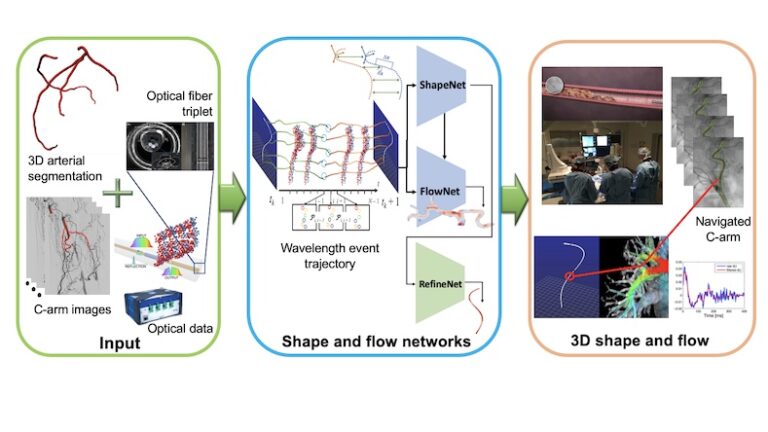The paper presents a navigation framework based on optical frequency domain reflectometry (OFDR) using fully-distributed optical sensor gratings enhanced with ultraviolet exposure to track the three-dimensional shape and surrounding blood flow of intra-vascular guidewires. While current fiber optic technologies provide means of tracking by measuring fibers under strain, they are limited to known geometrical models and do not account for external light variations. The proposed event-based dual branch network allows to track the shape and location of the sensing guidewire, in addition to inferring blood flow measurements from randomly distributed optical gratings. As input, it uses the segmentation of the pre-treatment arterial structure and stream of synchronized 2D C-arm images with the backscattered wavelength signals interrogated from the OBR system. Using the wavelength events, signal trajectories are first generated which captures the variations in backscattered strain during navigation. The network’s first component (ShapeNet) attempts to recover the 3D shape of the guidewire through temporal and spatial constraints linking the 3D vessel model with wavelength events. The other branch encompasses an attention-based temporal convolutional network (FlowNet) which allows to estimate blood flow around the sensing fibers. As a last step, RefineNet enables to adjust for slight mis-estimation, by integrating stability criterions with the detected vessels on C-arm images, to adjust both shape and flow outputs. Experiments performed on synthetic and animal models, as well as in a preliminary human trial show the capability of the model to generate accurate 3D shape tracking and minimal blood flow velocities differences, providing realistic physiologic and anatomical properties for intravascular techniques. The study demonstrates the feasibility of using the device clinically, and could be integrated within revascularization workflows for treating occlusions in arteries, since the navigation framework involves minimal manual intervention.

Shape and Flow Sensing in Arterial Image Guidance from UV Exposed Optical Fibers based on Spatio-temporal Networks
Sign-in or become an IEEE member to discover the full contents of the paper.
